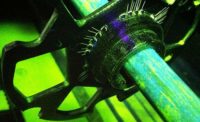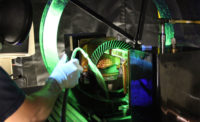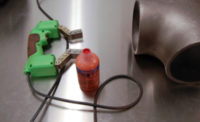The magnetic particle method of nondestructive testing is used for locating surface and near-subsurface discontinuities in ferromagnetic materials. It is dependent on the fact that when the material or part is magnetized, discontinuities, which lie in a direction transverse to the direction of the magnetic field, will cause a leakage field to be formed on the surface of the part. The presence of the discontinuity is detected by the use of fine, ferromagnetic particles applied over the surface. These particles will gather and are held by the leakage field. The particles form an outline of the discontinuity and indicate its location, size, shape and extent.
There are two essential components of the magnetic particle testing process, and each is important for reliable results. The first is creating the proper field strength and the right direction for the detection of the particular type of defect being sought. The second ingredient of a properly run test is the use of the proper type of magnetic particles to display the best possible indications.
In general, to function properly, the particles composing the medium in both the wet and dry method should fit the following criteria:
- Nontoxic
- Correct particle size for the application
- Ferromagnetic
- Free of contaminants
- Possess high permeability and low retentivity
- Provide high visibility
Particle Shape
The particles used in magnetic inspection are a combination of fusing iron oxide, a unique resin, and pigment (fluorescent or visible). If the particles have a spherical shape, they will have excellent mobility but will not be strongly attracted to the leakage field. On the other hand, long, slender particles may be strongly attracted to the leakage field due to their pronounced north and south poles but will have lower mobility. Particle size also plays an important part in the behavior of magnetic particles when in a magnetic field, which can be quite weak at a discontinuity. Large, heavy particles are not likely to be held in a weak field when such particles are moving over the surface; therefore, a very small discontinuity may be missed. On the other hand, very fine particles will be held by a very weak field; therefore, these particles may adhere to the surface where there are no discontinuities, especially on a rough surface, and may display too much background. These two opposing characteristics are overcome by blending particles of different shapes and sizes.
In actual use, particles never act as individuals. Due to the fact that they are magnetized in use, they become actual tiny magnets, because the material has some retentivity. These particles are drawn together as a result of their retained magnetism to form clumps or aggregates of particles. The particles tend to act as a unit when applied to the surface of a part for magnetic particle testing. The speed and extent to which this process takes place increases with the retentivity of the particle material. Agitating the suspension breaks up the aggregates, but they begin to form again as soon as agitation ceases.
Durability
Another important factor is durability, especially for particles used in wet inspection benches. These particles must be able to withstand being constantly circulated within the pump of the magnetic inspection bench or mechanically agitated and maintain its integrity. When the wet method is used, the medium concentrate is mixed with a liquid (light oil or water) to make a bath that is then applied onto the surface of the part while the magnetizing current is flowing for the continuous method, or the medium is applied after the magnetizing current is shut off for the residual method.
Particles used in a magnetic inspection bench, in most cases, are re-circulated using an impeller-driven pump. Over a period of time, this action will cause the pigment to detach from the iron oxide material. The lack of both bath and equipment maintenance can cause possible problems within the bath. Defective pumps can cause an increase of particle breakdown. One common mistake is to replace a defective pump with one that has a higher rpm rating. This naturally causes the particles to break down faster. It is advised that you call the manufacturer or an authorized service center when replacing any part on one of the units.
Bath Contamination
Bath contamination with acid or alkali from a pre-cleaning step or process can cause degradation of the particles. Also, processing hot parts may raise the bath temperature above acceptable levels (100 to 120 F), which softens the resin. When the bond of the iron oxide particle and pigment has deteriorated, increased background will be observed. This increased background could mask indications and some discontinuities can be missed. Also, frequent bath replacement causes increased material and labor costs that will affect revenue margins. Contamination can be minimized by keeping the bath covered when not in use and monitoring the bath concentration using the correct centrifuge tube. Using a quality product from a reliable supplier will also help in preventing problems in the magnetic particle inspection process. (Tables 3 and 4 show how to troubleshoot a suspension bath.)
Dry Method
The dry method is used under white light for detecting large, coarse discontinuities; these particles are usually larger than wet method, fluorescent particles. Dry method particles are manufactured in various colors for better surface contrast, usually in gray, red, black and yellow. (Table 1 shows the advantages and disadvantages of the dry method.)
Wet Method
Wet method particles are available in fluorescent, visible and dual-purpose types. This method is used to find very small and shallow discontinuities. Depending upon your requirement, specification or material, you have a choice of oil or water to suspend the particles in. There are advantages and disadvantages for both. Using oil creates a fire hazard, waste disposal issues, higher material cost, and possible skin irritation. Using water may cause corrosion issues (water bath concentrates contain water conditioners that will prevent this) and monitoring of the system will be increased due to evaporation. (Table 2 lists the advantages and disadvantages of the wet method.)
Your inspection will be more consistent and repeatable if you choose the correct equipment and quality material for your inspection.











